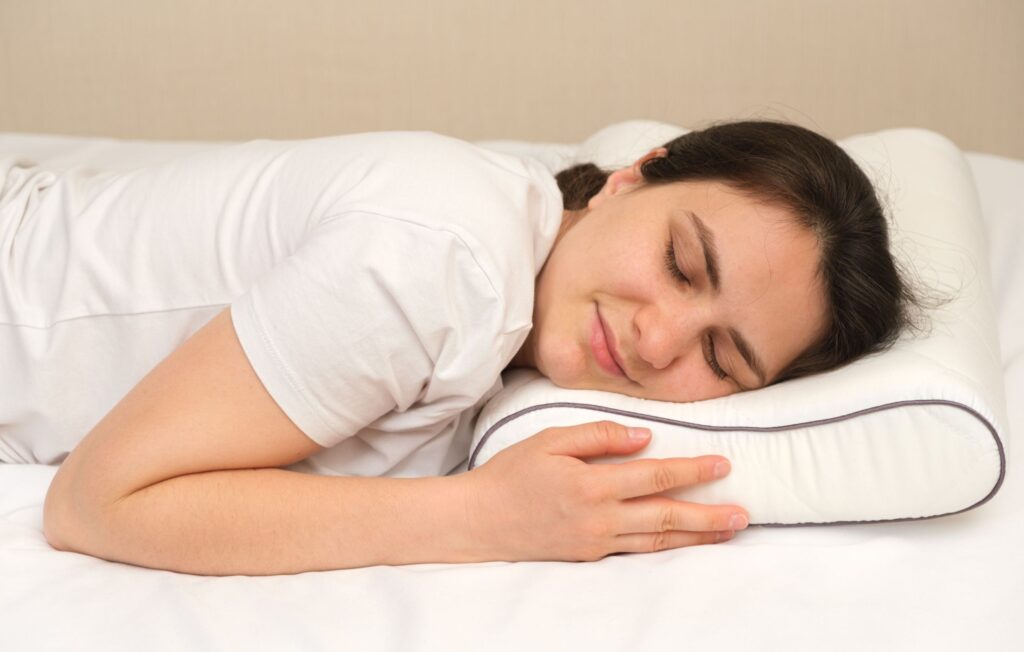Memory Foam Pillow
Are you sick of having sleepless evenings where you toss and turn all night long trying to find the ideal position? Do you experience neck pain, headaches, or a general lack of sleep when you wake up? If this is the case, it may be time to think about changing your bedding, starting with your pillow.
Because they allow for a comfortable and supportive sleep, memory foam pillows have become quite popular in recent years. This extensive guide will cover all you need to know about memory foam pillows, including its benefits and composition as well as how to pick the best one for you.

Understanding Memory Foam Pillows
Memory foam pillows offer individualised support and alignment by conforming to the shape of your head and neck. NASA originally created this ground-breaking material in the 1960s to be used in aeroplane seats to increase safety. Since then, it has made its way into many consumer goods, such as pillows and mattresses.
Composition of Memory Foam
A high-density polyurethane foam, memory foam is also referred to as viscoelastic foam. Its capacity to react to heat and pressure distinguishes it from conventional pillow fillers like feathers or down. A memory foam pillow softens and conforms to your specific shape when you place your head on it, effectively dispersing your weight.
Benefits of Memory Foam Pillows
Pressure Relief: Pressure points are effectively relieved with memory foam pillows. They support your head and neck, relieving pressure there and potentially easing neck and shoulder pain.
Spinal Alignment: A restful night’s sleep depends on proper spinal alignment. By encouraging natural alignment, foam pillows lower the possibility of awakening with a tight neck or back.
Durability: Durability is a hallmark of good memory foam pillows. They outlive ordinary pillows since they can keep their support and structure for a longer period of time.
Hypoallergenic: Memory foam is a great option for allergy sufferers because it is resistant to dust mites and other allergens.
Motion Isolation: Memory foam helps reduce motion transfer if you share a bed with a partner that moves around a lot at night, allowing you to sleep more soundly.
Custom Comfort: There are many different sizes and shapes of memory foam pillows, including contoured, shredded, and classic designs. You can select the option that best meets your comfort preferences thanks to the variety.
Temperature Regulation: A typical issue with foam-based products, overheating is prevented by the cooling mechanism used in many memory foam pillows.
Improved Sleep Quality: In the end, memory foam pillows are designed to improve the quality of your sleep by providing superior comfort and support.

Types of Memory Foam Pillows
Traditional Memory Foam Pillows: These pillows offer a consistent sleeping surface and are made of durable memory foam. They are available in a range of thicknesses to allow various sleeping postures.
Contoured Memory Pillows: Contoured pillows feature an ergonomic design with a dip in the centre to support the neck and cradle the head. People with neck problems or those who favour particular sleeping positions can benefit the most from them.
Shredded Memory Pillows: Small fragments of memory foam are included in shredded memory foam pillows, providing for greater flexibility and adjustability. These pillows can be moulded and shaped whatever you choose.
Gel-Infused Memory Pillows: Memory foam in gel-infused pillows has a layer of cooling gel built into the foam. This promotes heat dissipation and preserves a temperature conducive to sleeping.
Cervical Foam Pillows: These pillows are made with a noticeable neck roll to give the cervical spine additional support. For people with spinal conditions or recurrent neck pain, they are frequently advised.
Choosing the Perfect Memory Foam Pillow
Your ability to sleep well might be considerably impacted by your choice of memory foam pillow. Here are some things to think about before choosing:
1. Sleeping Position
It’s important to consider your favourite sleeping position while choosing the best memory foam pillow:
Back Sleepers: Medium-thick pillows that support the natural curve of the neck are often beneficial for back sleepers.
Side Sleepers: To maintain spinal alignment, side sleepers frequently require firmer pillows with more height.
Stomach Sleepers: To prevent neck pain, stomach sleepers typically need a softer, thinner cushion.
2. Pillow Density
There are many densities of foam pillows, usually labelled as low, medium, or high. Your preferred sleeping position and personal preferences will determine the ideal density for you.
Low Density: These pillows are more malleable and softer. For back and stomach sleepers who like a softer feel, they are suitable.
Medium Density: The support and comfort levels of medium-density pillows are balanced, making them ideal for a variety of sleepers.
High Density: These firmer pillows offer good support. For side sleepers and anyone with neck trouble, they are great.
3. Pillow Size
Think about the pillow’s proportions, especially if your body type is large or little. A cushion that is too little might not offer enough support, while a pillow that is too large might be uncomfortable.
4. Cooling Features
Look for memory foam pillows with cooling technology, such as gel-infused foam or breathable coverings, if you have a tendency to get hot when sleeping.
Conclusion
A memory foam pillow purchase can significantly improve your sleep and general well-being. Understanding the various memory foam pillow options, taking into account your own requirements and preferences, and according to the recommended maintenance guidelines will allow you to reap the rewards of deep, revitalising sleep every night. Say good-bye to uncomfortable pillows and hello to memory foam’s luxurious softness. You’ll wake up prepared to face each day, and your neck and spine will thank you for it.